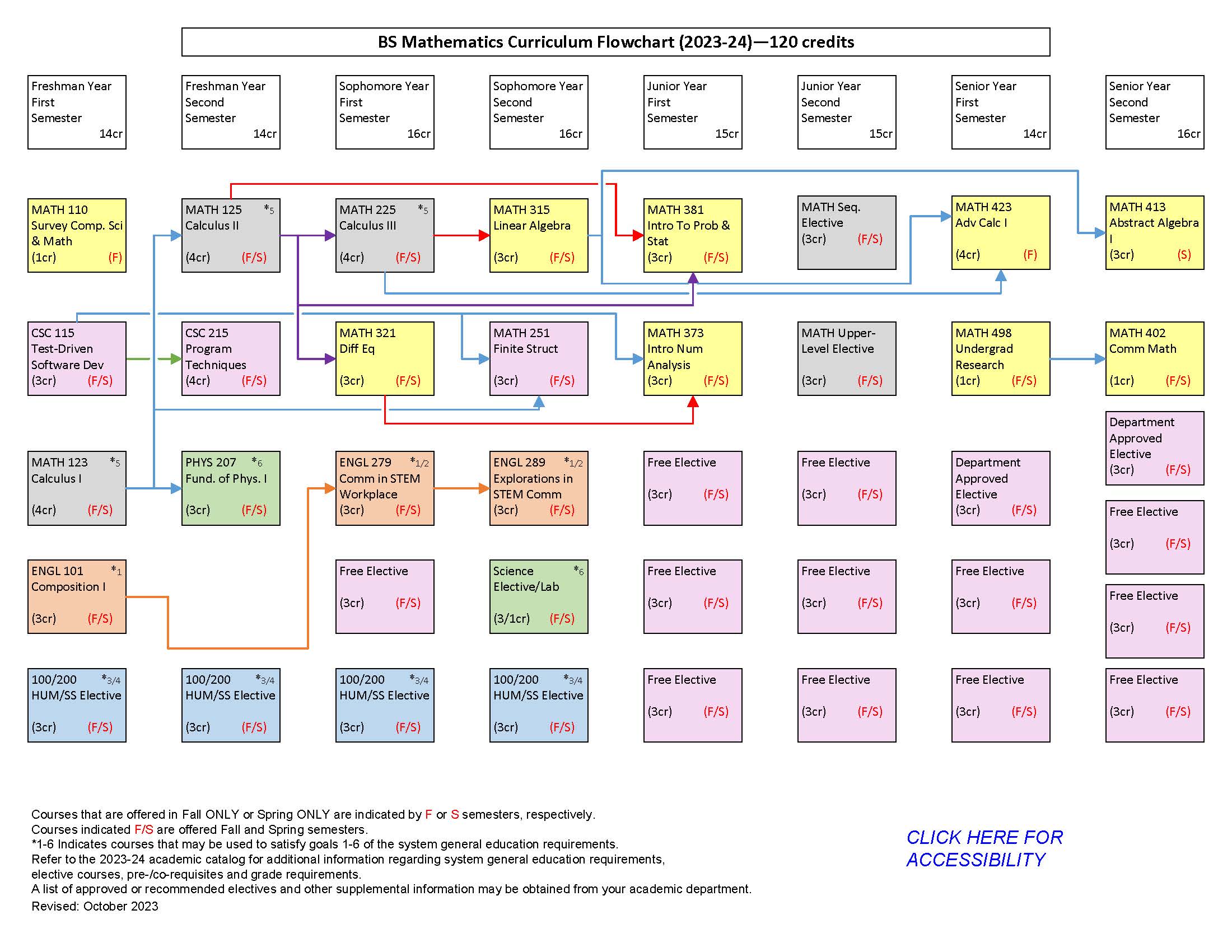| |
| |
Dec 06, 2025
|
|
|
|
|
2023-2024 Academic Catalog [ARCHIVED CATALOG]
Mathematics, BS
|
|
 Return to: Academic Programs Return to: Academic Programs
Contact Information
Travis Kowalski, Department Head
Mathematics
McLaury 206C
(605) 394-2471
E-mail: Travis.Kowalski@sdsmt.edu
Department Website
Students are responsible for checking with their advisors for any program modifications that may occur after the publication of this catalog.

MATH Flowchart
|
Second Semester
- MATH Sequence Elective Credits: 3 4
- MATH Upper-Level Elective Credits: 3 5
- Free Elective(s) Credits: 9
Notes:
For the bachelor of science in Mathematics, a student must have a departmental grade point average of at least 2.00 in all MATH courses 300 level or higher. 1 Fulfills General Education requirement. Students should consult the “General Education Requirements ” section of this catalog for a complete listing of all general education requirements. 2 The CSC 115 requirement can also be fulfilled by either CSC 150/150L or CSC 170/170L . The CSC 215 requirement can be fulfilled by CSC 250. 3 Select one course from BIOL 151 , BIOL 153 , CHEM 112 , CHEM 114 , GEOL 201/201L ,or PHYS 209 , and the corresponding lab for that course for a total of at least four credits. 4 Select three credits from the MATH Sequence Elective list below. 5 Select three credits from the MATH Upper-Level Elective list below. 6 Select three credits from the Department Approved Elective list below. MATH Sequence Electives
Select three credits from the list below. MATH 415 may only count towards one elective requirement: MATH Upper-Level Elective
Select three credits from the list below: Department Approved Electives
Select three credits from the list below. An additional course from the MATH Upper-Level Elective list may also be used: AES: AES 401/501 , AES 404/504 , AES 419/519 , AES 430/530 , AES 455/455L/555/555L BIOL: BIOL 480/580 BME: BME 300 , BME 302 , BME 303 , BME 304 , BME 305 , BME 306 , BME 402/402L , BME 403 , BME 404/404L CBE: CBE 317 , CBE 318 , CBE 321 , CBE 343 , CBE 417 , CBE 424/524 , CBE 433 , CBE 444/544 , CBE 445/545 , CBE 450/550 , CBE 484/584 , CBE 488/588 CEE: CEE 336/336L , CEE 433/533 , CEE 457/557 , CEE 468/568 , CEE 475/475L/575/575L CENG: CENG 320/320L, CENG 420/420L, CENG 421/421L/521/521L, CENG 444/444L/544/544L, CENG 452/452L CHEM:CHEM 342, CHEM 344 CSC: CSC 315, CSC 372, CSC 412/512, CSC 414/514, CSC 416/516, CSC 433/533, CSC 424/524, CSC 445/545, CSC 448/548, CSC 449/549, CSC 454/554 EE: EE 313, EE 314/314L , EE 362 , EE 381 , EE 382 , EE 404/504 , EE 421/421L/521/521L , EE 447/547 , EE 448/548 , EE 449 , EE 451 , EE 452/452L/552/552L , EE 453/453L/553/553L , EE 456/456L/556/556L , EE 481/481L/581/581L , EE 483/483L/583/583L EM: EM 321, EM 328, EM 331 ENGM: ENGM 435/535 GEOE: GEOE 475/475L/575/575L GEOL: GEOL 419/519 , GEOL 450 IENG: IENG 362, IENG 415/515, IENG 425, IENG 441 ME: ME 312, ME 313, ME 316, ME 331, ME 352, ME 402/502, ME 404, ME 419, ME 423, ME 425, ME 428/428L/528/528L, ME 430, ME 444/544, ME 453/453L/553/553L, ME 455/455L, ME 457/557, ME 460 MEM: MEM 410/510, MEM 425/525, MEM 445/545/445L/545L, MEM 450/550 MET: MET 310, MET 320, MET 321/321L, MET 330, MET 422, MET 433, MET 440/540, MET 443, MET 445/545 NANO: NANO 401, NANO 445/545, NANO 571 PHYS: PHYS 341, PHYS 343, PHYS 361, PHYS 404/504, PHYS 421/521, PHYS 439/539, PHYS 445/545, PHYS 451/551, PHYS 471/571, PHYS 481/581 Objectives and Outcomes
Student Outcomes: - Students will use mathematics to effectively formulate and solve problems, including (but not limited to) those that arise in mathematics, science, and engineering.
- Students will critically interpret data and analyze solutions.
- Students will apply appropriate mathematical software to solve problems arising in the profession.
- Students will collaborate with colleagues and communicate ideas using appropriate mathematical language and notation, both orally and in writing.
|
 Return to: Academic Programs Return to: Academic Programs
|
|
|